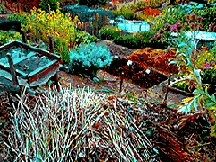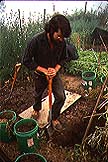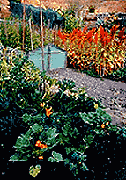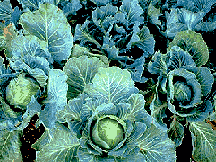John
Jeavons
Ecology Action & Biointensive
Sustainable Mini-Farming
"Forget about growing
vegetables. Think instead about growing soil, for it is really soil that feeds
you." -- John Jeavons
*
Full
Potential - Carbon and Calorie Mini-Farming
"Over the past 25 years, Biointensive mini-farming has spread to 109
countries worldwide, where it is serving people with all varieties of soils,
climates and cultures in nutrition intervention - allowing people to
grow their own vitamins and minerals where normally they would experience
shortages. That is exciting news! But what is even more exciting is that they
can tap into the full potential of Biointensive sustainable mini-farming.
Not only can Biointensive mini-farming produced essentially all of the
vitamins and minerals that one person needs annually in one or two beds (100 to
200 square feet, or 9.3 to 18.6 square meters) of carefully selected
vegetables, but Biointensive can, in fact, produce delicious complete
nutritional diets in a fraction of the area needed by conventional chemical or
organic mechanized farming techniques. For example, approximately 10,000 square
feet are needed with such practices to produce an average complete vegetarian
diet containing no animal products (22,000 to 43,000 square feet for an average
American diet), but only about 2,000 square feet are needed to produce
the same diet with Biointensive mini-farming. That can go a long way
toward feeding increasing and hungry populations as the world works to decrease
population growth to sustainable rates."
*
How To Grow More Vegetables
Than You Ever Thought Possible On Less Land Than You
Can Imagine
 ****
****
John Jeavons, compost crops
for carbon, and curing compost beds.
"However, this is only part of Biointensive's potential. Conventional
chemical or organic mechanized farming techniques not only take a lot of room
to produce a diet, but they also deplete the soil in the process! Conventional
chemical and organic farms are generally not producing sufficient compost
material high in carbon so that enough cured compost and humus can be
produced to maintain a healthy organic matter level in the soil. To do so would
require up to twice the area - from 10,000 square feet up to as much as 20,000
square feet (about half an acre) for a vegetarian (vegan) diet. However, with
Biointensive Sustainable Mini-Farming, as little as 4,000 square feet
(about 1/10th of an acre) is needed to produce a complete diet to
feed one person annually and enough compost to maintain and even improve
the health of the soil. We are excited about this! It becomes possible for one
person to grow all of his or her family's food using truly sustainable methods
that maintain the fertility of the soil without relying on nonrenewable
resources like petrochemicals or imported organic matter."
 John Bybee double digging to prepare soil structures like those found
in nature in a well established ecosystem, and closely planted sprouts that
fill in space around themselves for insect protection, moisture retention, and
the maintenance of a locally beneficial climate.
John Bybee double digging to prepare soil structures like those found
in nature in a well established ecosystem, and closely planted sprouts that
fill in space around themselves for insect protection, moisture retention, and
the maintenance of a locally beneficial climate.
Taking The Next Step
"In order to help take the next step - from nutrition intervention
to complete diet sustainable mini-farming - Ecology Action has created the
Calorie/Carbon Worksheet. It is designed to be an easy way for farmers
and gardeners, regardless of the agricultural methods they use, to ensure that
they are growing enough calories (the nutritional requirement that takes
the most area to produce) to feed themselves and enough carbon (to be
composted) so that enough cured compost is generated and added back to the land
to maintain the farm's organic matter level and overall, long-term
fertility."
"We have also developed the
Essential Points Information Sheet. This is a list of the most important
topics to understand about Biointensive Sustainable Mini-Farming at
beginning, intermediate and advanced levels: Double-digging, Compost,
Carbon/Calories, Close Spacing Plantings, Companion Plantings, Open-pollinated
Seeds/Seed Saving, Water Conservation, Energy Conservation, Area Needed, Whole
System Farming. It is difficult in times of transition and instability to
remember that we must not only feed ourselves and our families, but we must
also feed Our "Extended" Family, the Soil. Let us know if you are
interested in learning more about these helpful worksheets. We welcome your
comments."



Mini-greenhouse amid complex plantings, cabbages
growing closely packed, and Einkorn, the living stone age ancestor of modern
wheat, Willits, California.
The Value Of
Wilderness
"Farms are usually poor sustainers
of Nature's wonderful and sophisticated plant and animal diversity. There is
no substitute for wilderness to provide for and maintain healthy and
diverse populations of the many, many species with which we share this planet
and upon which we depend. With Biointensive methods, farmers can
dramatically reduce the amount of land and water that must be devoted to
farmland for our food, thereby allowing more land to remain in the wild. Alan
Chadwick strongly advocated a goal of 3/4 of the Earth's land surface being
left in wildlands with only 1/4 being under cultivation and human management.
This seems like a good guideline to help us remember to revere the land and
respect its natural limits."
- - - By John Jeavons - -
-
Living soil humus from compost beds is also essential for
making Seed Balls!
For more information contact:
Ecology Action - 5798 Ridgewood Road - Willits,
California 95490 - TELEPHONE: (707) 459-0150
All Photographs And Text
Copyright (C) 1996 Jim Bones (Unless Otherwise Indicated) Box 101, Tesuque,
N.M. 87574 (505-955-0956)
"Light Writings"
http://www.seedballs.com  ****
****
 John Bybee double digging to prepare soil structures like those found
in nature in a well established ecosystem, and closely planted sprouts that
fill in space around themselves for insect protection, moisture retention, and
the maintenance of a locally beneficial climate.
John Bybee double digging to prepare soil structures like those found
in nature in a well established ecosystem, and closely planted sprouts that
fill in space around themselves for insect protection, moisture retention, and
the maintenance of a locally beneficial climate.


